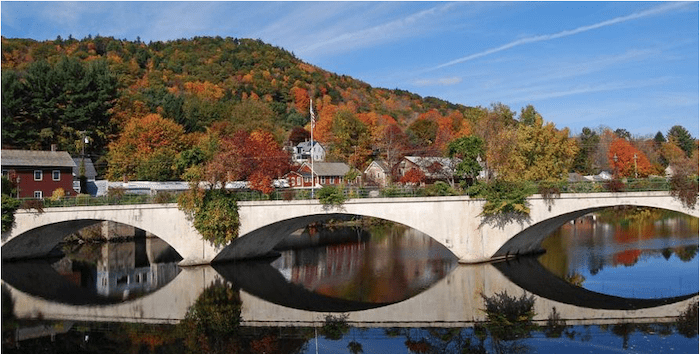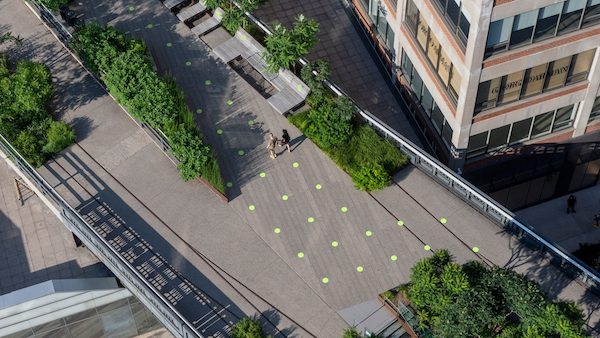Visual Arts Commentary: The Bridge of Flowers, Shelburne Falls, Massachusetts
By Mark Favermann
An appreciation of a footbridge that intertwines nature with our humanity.

The Bridge of Flowers, a digital painting (2019) by Erin Donnellan.
Whether it’s baking sourdough bread or binge-watching the good, the bad, and the ugly on TV, we are all suffering from various degrees of online fatigue. Some are awkwardly learning to use Zoom or other similar virtual meeting channels for business and family; others are dealing with the psychological effects of isolation for months. Stay-at-home and lockdown ennui takes many nefarious forms in the age of COVID-19.
Between bouts of monotony, boredom, and weariness, we tend to reflect too little and deflect too much. The expression “stop and smell the roses” is not just about flowers, but how to live our lives in ways that encourage a deeper appreciation of the world around us. The phrase (though ridiculed) is about making us slow down and notice the little things that make life worthwhile. Given all the challenging news — quarantine, isolation, illness, economic decline, depression, fear, and chaos — it is definitely time to smell the flowers.
As a metaphor, a bridge can mean many things. It can signify a way to exchange ideas, to link people and locations together, to connect as a means of decreasing loneliness. On an elemental level, it is a more efficient way of getting from one point to another. A bridge increases the range of human options while it also symbolizes life changes.

The Bridge of Flowers in the Fall; Photo: courtesy of Picture by Reflections by Erica.
A wonderful, brilliantly planted bridge structure is located on the eastern side of the Berkshires in the delightfully quaint village of Shelburne Falls, MA—the Bridge of Flowers. The 400-foot-long bridge is a plant-lover’s paradise promenade, a narrow linear park projecting across the water. The over 500 varieties of flora that cover the bridge are expertly planted to ensure that they bloom continuously from April through October. Included in the walking bouquet are flowers, vines, and shrubs, with many rare and historical assortments.
Built for trolleys between the small towns of Shelburne and Buckland over the Deerfield River in 1908, this bridge is more than just an arched means of conveyance; it is a distinctive landmark of industrial infrastructure created for turn-of-the-20th-century America. It was designed by MIT-trained civil engineer Edward S. Shaw of Cambridge, MA. The trolley company went out of business in 1927. Two years later, the structure was reborn as the Bridge of Flowers.
Once the bridge was covered in weeds, local housewife Antoinette Burnham came up with the idea of transforming the bridge into a garden. Because it was no longer needed as a footbridge, but could not be demolished because it carried a water main between the two towns, the community agreed to her idea. The Shelburne Area Woman’s Club sponsored the project in 1928. The next year, after heavy weeding, massive amounts of loam, a plant-friendly mixture of sand and clay, and several loads of fertilizer were brought to the bridge. To pay for these materials, the Shelburne Area Woman’s Club raised $1,000 — about $15,000 in today’s dollars. From throughout the Northeast, folks donated flowers to be planted and cultivated.

The High Line in better times, Photo courtesy of The Friends of the High Line.
The Bridge quickly became an early and excellent model of rejuvenated beauty, a pioneering effort at creative recycling that also served as a visionary beacon for community and visitors. It is free of charge; blooms change from spring to fall. Located on the bridge is a small memorial dedicated to veterans of World Wars I and II who lived in Buckland and Shelburne.
About two hours or so from Boston, the bridge is a near perfect day trip destination for those eager to escape the COVID morass. It offers spectacular views of the nearby mountains and the Deerfield River. Fall foliage is especially striking. Quaint restaurants and stores line the streets of Shelburne Falls. The area has craft artist residents in abundance, and their wares can be seen and purchased in various shops and galleries.
By the early ’80s, the bridge needed substantial structural repairs and organic renovation. During this period, the Bridge of Flowers was temporarily closed. At a cost of nearly half a million dollars, much of it donated by generous community residents and businesses, the structure was repaired and reopened. An inspirational note: residents and businesses voluntarily cared for many of the bridge’s important plants and flowers at their homes during this reconstruction period.
For over two decades, the Bridge’s head gardener has been Carol DeLorenzo, and she has been in charge of generations of volunteer gardeners. When the foliage is in season, they spend countless hours weeding, cleaning, and caring for the plants and flowers. Their work is mainly responsible for the beauty of this special place.

A one-way system of dots for social distancing during the pandemic, created by Designer Paula Scher, Photo: Pentagram.
In Manhattan, the 1.45 mile long High Line is a much newer and more highly touted elevated linear American park. It is a New York City rail trail located on a former New York Central Railroad spur on the west side of Manhattan. The High Line was designed by Diller Scofidio + Renfro, and Piet Oudolf. The architectural firm of Diller Scofidio + Renfro designed Boston’s ICA and Lincoln Center’s renovation as well.
The Bridge of Flowers was not on the minds of designers and the Friends of the High Line (the project’s organizers and donors); they say they were inspired by the 2.9 mile long Coulée verte René-Dumont or Promenade plantée (tree-lined walkway), a similar Paris project completed in 1993 on a set of old aqueducts. It is hard to believe that no one involved over the years with the High Line had any inkling of the Bridge of Flowers. Maybe it was a case of the intensely urban versus the gently bucolic? Or was it a creative oversight?
Repurposing the railway into an urban park began in 2006. The High Line opened in phases during 2009, 2011, and 2014. The last segment debuted on June 4, 2019. Last year, the High Line had over eight million visitors. Initially closed because of the pandemic, it reopened on July 19 of this year. With the proper precautions — social distancing and wearing masks — the environment can once more be experienced, though with differences. Alas, at the moment the Bridge of Flowers can only be appreciated from a distance. Let us hope it reopens soon — with the proper rules in place. It is definitely time to somehow smell the flowers.
An urban designer and public artist, Mark Favermann has been deeply involved in branding, enhancing, and making more accessible parts of cities, sports venues, and key institutions. Also an award-winning public artist, he creates functional public art as civic design. The designer of the renovated Coolidge Corner Theatre, he is design consultant to the Massachusetts Downtown Initiative Program and, since 2002, he has been a design consultant to the Red Sox. Writing about urbanism, architecture, design and fine arts, Mark is Associate Editor of Arts Fuse.

Another great article Mark. As we talked about, this bridge is a Massachusetts treasure made more special because it is an original. We don’t know what inspired Antoinette Burnham to create something so beautiful, but every time I visit, I am glad she did.
Update: Due to the pandemic, the Bridge of Flowers is closed for the 2020 year. Although the Commonwealth of Massachusetts has entered Phase III of re-opening and has issued guidelines for botanic gardens to re-open, the Bridge of Flowers cannot meet those guidelines. Unfortunately, the path on the bridge is too narrow to permit physical distancing, and they have no paid staff to monitor appropriate social distancing or the wearing of masks. They are unable to “schedule” visits or tours in advance. Therefore, sadly, the Bridge of Flowers is closed for the year.
Love the article